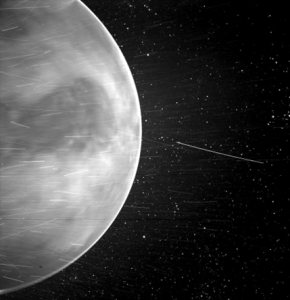Parker Solar Probe
The Parker Solar Probe is an aspect of NASA’s Living With a Star program. The purpose of this program is to investigate facets of the Sun-Earth system. Goddard Space Flight Center manages the Living With a Star program for NASA’s Science Mission Directorate. The Parker Solar Probe is managed by the Johns Hopkins University Applied Physics Laboratory (APL). APL built and designed the Parker Solar Probe and now runs its operations.[1]
The Parker Solar Probe was launched at the Cape Canaveral Air Force Station in Florida on August 12, 2018. It will bring its orbit closer to the Sun over nearly seven years and seven flybys using Venus’ gravity. The Probe will fly through the outermost part of the Sun’s atmosphere (the corona) within the orbit of Mercury and over seven times closer than spacecrafts in the past. This could be close as 3.8 million miles to the star’s surface.[2]
The Parker Solar Probe will use in situ measurements and imaging to aid in understanding the corona. More information can be collected to build knowledge about the origin and evolution of solar wind. That information will assist in making predictions about changes in Earth’s space environment, which affect technology and life on Earth.[3]
The instruments and spacecraft are protected from the Sun’s heat with a 4.5-inch-thick carbon-composite shield. The spacecraft needs to withstand temperatures that can reach 2,500 F (1,377 C). Thermal engineering advances make this achievable. Four instrument suites are carried by the Parker Solar Probe that will assist in solar wind imaging, in addition to plasma, energetic particle, and magnetic field studies.[4]
Science goals for the Parker Solar Probe include:
- Tracing the way energy and heat move through the solar corona.
- Investigating what quickens solar energy particles and solar wind.[5]
Instruments
The four instruments that make up the Parker Solar Probe are FIELDS, WISPR, SWEAP, and ISʘIS.[6]
FIELDS
The FIELDS instrument uses high time resolution in the inner heliosphere to measure waves and turbulence. Five, two-meter-long antennas made of niobium alloy are used to measure the electric field surrounding the spacecraft. These measurements occur over a broad frequency range that can happen in situ, directly, or remotely. While four of the antennas measure fast and slow solar wind in sunlight, the fifth antenna is located perpendicular to the others and aids in the three-dimensional image of the electric field when it’s in higher frequency. It’s possible for FIELDS to appraise the magnetic field due to three magnetometers (a search coil magnetometer and two fluxgate magnetometers) that help in this process. The Space Sciences Laboratory at the University of California, Berkeley, led the team who designed and built FIELDS. This team also operates the instrument.[7]
WISPR
Parker Solar Probe only carries one imaging instrument on its spacecraft. The Wide-Field Imager, known as WISPR, captures images of coronal mass ejections (CMEs) and jets and other ejecta from the Sun. Once structures of this kind move toward the spacecraft from the Sun, the other instruments on board measure the structures in-situ. This provides insight into the relationship between the large-scale coronal structure and the near-Sun physical measurements. Images are obtained by blocking a large amount of the Sun’s light with a heat shield. Leftover light is reflected and absorbed by baffles and occulters. This light has been reflected or diffracted from the end of the heat shield or various parts of the spacecraft.[8]
Radiation-hardened Active Pixel Sensor CMOS detectors are featured in the two cameras used by WISPR. The lenses of these cameras consist of a radiation hard BK7, which is often used in space telescopes. The Solar and Heliophysics Physics Branch at the Naval Research Laboratory in Washington D.C. is responsible for the development and design of WISPR. Development of the observing program will be conducted by the Solar and Heliophysics Physics Branch as well, with Russell Howard as the principal investigator.[9]
SWEAP
the Solar Probe Cup (SPC) and the Solar Probe Analyzers (SPAN) are instruments that make up the Solar Wind Electrons Alphas and Protons (SWEAP) investigation. The copious particles in solar wind (electrons, protons, and helium ions) are counted by SPC and SPAN. Measurements of temperature, velocity, and density are used to increase our comprehension of coronal plasma and solar wind.[10]
The SPC, or a Faraday cup, captures charged particles in a vacuum. Formed of highly transparent grids, the SPC is bare to all the energy, heat, and light emitted from the Sun. Cosmic rays and photoionized electrons are sorted out by the variable voltage grid, which avoids bias in measurements. A temperature of 3,000 F can be reached by the SPC and various components are electrically isolated using pieces of sapphire. The density, velocity, and temperature of the Sun’s plasma are measured by the SPC at a rate of 146 measurements per second as it travels near to the Sun.[11]
SPAN is made up of two instruments (SPAN-A and SPAN-B). Their fields of view allow them to see areas of space that SPC cannot. Particles that meet the detectors will go through a maze of deflectors and voltages that will sort them by charge and mass. SPAN-A measures electrons and ions while SPAN-B only focuses on electrons.[12]
Most of SWEAP was built at the Smithsonian Astrophysical Observatory in Cambridge and the Space Sciences Laboratory at the University of California, Berkeley. Operations of SWEAP are shared between these institutions and Justin Kasper is the principal investigator.[13]
ISʘIS
Two complementary instruments are used for the Integrated Science Investigation of the Sun (ISʘIS). These instruments are used to measure particles that span a vast scope of energies. Energetic Particle Instrument-Lo (EPI-Lo) and Energetic Particle Instrument-Hi (EPI-Hi) are the energetic particle instruments that make up ISʘIS.[14]
The EPI-Lo is made up of 80 viewfinders that allow for a large field of view for low-energy particle observation. After an ion goes into a viewfinder, it takes a journey through two carbon-polyimide-aluminum foils until it meets a solid-state detector. When they meet, electrons are produced from the foils where they are measured with a microchannel plate. This process reveals the particle species.[15]
Detectors are stacked to make up three particle sensors that measure particles the EPI-Lo cannot (higher energy particles). Reduction of background noise and determination of particle direction are achieved with the front layers of the sensors made of ultra-silicon forming geometric segments. Ionization is performed to identify charged particles and when the EPI-Hi is at its closest to the Sun, it’s possible to detect 100,000 particles per second.[16]
The combination of these tools allows ISʘIS to examine solar energetic particle energies and high-energy solar wind particles undetected by SWEAP.[17]
Princeton University leads ISʘIS with principal investigator, David McComas. Much of ISʘIS was built at John Hopkins Applied Physics Laboratory with help from Southwest Research Institute and NASA’s Goddard Space Flight Center. The University of New Hampshire is the site of operations for the ISʘIS Science Operations Center.[18]
RECENT UPDATES
A year after the Parker Solar Probe was launched, NASA reported it had taken two full orbits around the sun and had collected two times the amount of data anticipated for collection.[19] In December 2019, NASA released information collected by the Parker Solar Probe in a collection of four papers published in Nature. These papers dive into the Parker Solar Probe’s observations from its first two flybys of the Sun.[20]
NASA reports these papers “reveal new insights into the processes that drive the solar wind – the constant outflow of hot, ionized gas that streams outward from the Sun and fills up the solar system – and how the solar wind couples with solar rotation. Through these flybys, the mission also has examined the dust of the coronal environment, and spotted particle acceleration events so small that they are undetectable from Earth, which is nearly 93 million miles from the Sun.”[21]
In February 2021, NASA reported that the Parker Solar Probe attained images of the Venusian surface’s thermal emission through its instrument WISPR, in July 2020. This was an indication of more instrument capabilities. Specifically, the team was curious about WISPR’s reactivity to infrared light. This discovery could reveal WISPR’s capability to examine dust in the inner solar system and around the sun. If not, it’s possible that this image captured a “window” in the Venusian atmosphere.[22]
The image WISPR captured of Venus during the July 2020 flyby is below:

Source: NASA
NASA released news about Venus’ orbital dust ring in April 2021. Star and dust background are removed from WISPR’s images to get a clear vision of solar wind. After the Parker Solar Probe executed rolling maneuvers as a part of its process for another solar flyby, a change of camera orientation revealed Venus’ static dust ring. WISPR provided a 360-degree view of Venus’ orbital dust ring. The density of the dust by Venus’ orbit is around 10% more dense than surrounding regions. More information about these findings can be found through published results in The Astrophysical Journal. John Hopkins University Applied Physics Laboratory can also provide additional information about Parker Solar’s Probe’s observations.[23]
As of February 2022, the Parker Solar Probe has provided images of Venus’ surface. These images, in visible light, show the whole nightside and an oxygen halo bordering the planet. NASA reveals data like this may assist in answering questions about why Venus is inhospitable, as opposed to Earth.[24]
Updated November 2022, by Jackie Johnson

Comments are closed.